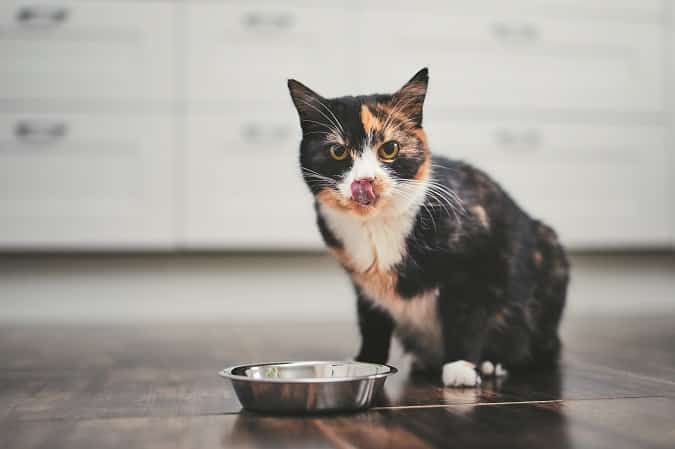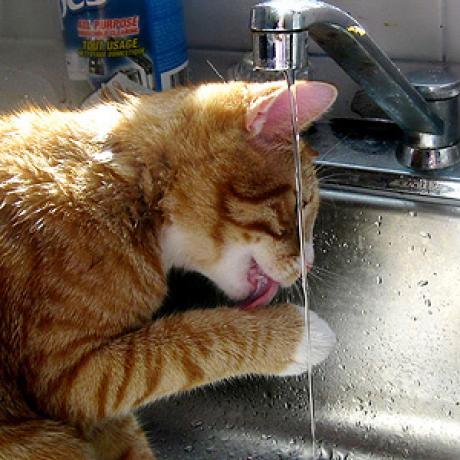When the thermometer shoots skyward during the summer months, your fur-covered feline may be at risk for the same kind of health problems that plague overly hot humans: heart difficulties, heat stroke, breathing issues and more.
“Cats are like people,” says Humane Society spokesperson Nancy Peterson. “They can become dehydrated and suffer organ failure and die if they get too hot.” Because summer temperatures in general appear to be on the rise, it helps to be aware of the dangers heat poses for your cat and ready to enact measures necessary for keeping kitty cool.
First, here’s what not to do:
- Do NOT leave your cat in a parked car. Don’t do this even for a few minutes. The inside of a car can heat up rapidly, making it much hotter than the outside temperature. Leaving the window open a few inches does not make the car cooler inside.
- Don’t forget to leave fresh water for your cat. Leave several bowls of water in the house so your cat will be sure to get plenty of it.
- Don’t shave your cat’s fur. Your feline’s fur offers some protection against sunburn. Cats that are pale or have light-skinned fur must stay out of the sun. “The ears and tips of noses of light-colored cats can get skin cancer,” says Bernadine Cruz, DVM, of Laguna Hills Animal Hospital, a member of the American Veterinary Medical Association. Applying sunscreen could help, but most cats will find a way to lick off the potentially toxic substance pretty quickly, says Dr. Cruz.
- Don’t tether your cat outside. Even if you think shade will protect your cat, the sun may shift, exposing the cat to direct sunlight before you realize it.
- Don’t ignore signs of heat stroke “The signs include panting rapidly, having trouble breathing and increased heart rate,” says Peterson. “A cat may act like it’s drunk by walking strangely, and its gums will be redder than normal.” If you notice any of these symptoms, wrap your cat in a cool, wet towel, and get it to your veterinarian or an animal hospital as quickly as possible.
To ensure you never have to make that emergency visit, follow these suggestions for keeping your cat cool:
Provide a Cool and Comfy Living Space
- Cool down your house as much as possible before you leave for work. Cover the windows and leave the air conditioning on “low,” if you can.
- If you don’t have air conditioning, place fans in the windows and run them on “exhaust” to circulate the air without sucking in the hot air from outside, suggests Karen Commings, author of The Cat Lover’s Survival Guide.
- Put small plastic containers filled with water in the freezer overnight. During the day, place these containers (now filled with blocks of ice) around your cat’s favorite sleeping spot.
- Freeze a bottle of water and place it in your cat’s bed, or place a package of frozen peas just under the covering of your cat’s bed. You can later eat the defrosted peas for dinner!
- If possible, allow your cat access to your basement, says Commings. This could particularly benefit older cats, which may not be as mobile, or able to locate a cool spot for themselves.
- Consider keeping your cat in the bathroom during the day, says Dr. Cruz. Cats sometimes like to lie on the cool tiles, in the bathtub or in the sink.
- If you have a screened-in patio where your cat likes to hang out, put up shades on the sides that face the sun. Provide plenty of fresh water. Check on the bowl throughout the day to make sure the water hasn’t evaporated.

Make Essential Car Trips Tolerable for Your Feline Passenger
- If you have to go on a car trip with your cat, travel at night or early in the morning when it’s coolest, says Dr. Cruz.
- Keep the car AC on, but make sure that the airflow actually reaches your cat’s carrier, Dr. Cruz advises.
- Lay a wet towel over your cat’s carrier if you must travel with your pet in the car during the day.
- Keep a spray bottle of cold water handy to wet your cat’s coat during any necessary car trips.
- Fill the feed cups inside the carrier with crushed ice for extra cooling.
- Buy a small battery-operated fan to attach to the outside of your cat’s carrier. Keep extra batteries on hand in case you need them.

Adjust Water, Play and Travel Schedules Accordingly
- Place your cat’s food and water bowl away from sunlight, says Commings. Fill the water bowl with ice cubes to keep the water chilled for hours.
- Keep activity to a minimum. Don’t encourage your kitty to play on hot days.
- Monitor your cat when the heat soars. If possible, dash home on your lunch hour to make sure the water dish is filled and that your cat appears healthy and happy. If you’re going out in the evening, check in at home first. If you’re heading out for a day trip, such as a visit to the beach, enlist a neighbor to look in on your cat while you’re gone.
Even Cooler Tips (For Extreme Heat, 80 degrees Fahrenheit+)
- Buy an electronic, drinking-fountain style water bowl, suggests Commings. “Add some ice cubes to the water to cool it down, too,” she says.
- Consider buying a cat bed that stays comfortably cool with low-voltage electricity.
- If you’re unsure that your house will be cool enough for your cat, line up a friend or cat sitter with a cooler home now who would be willing to keep your pet for the day.
Summer heat can be stressful for everyone, but our cats depend on us to make sure they’re safe and healthy. Taking the steps to ensure that your kitty is cool and comfortable is an important part of being a responsible and loving pet owner. Your cat will thank you many times later in its usual way, with lots of head butts, purrs, affection and loyal companionship.
